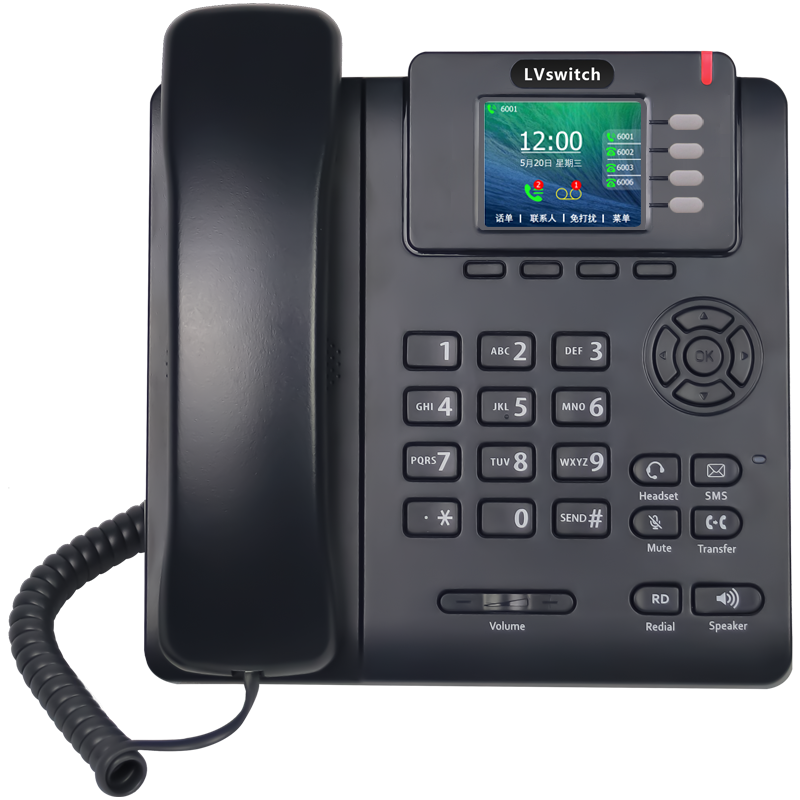LVswitches is a leading technology solutions provider.We provide Voip Telephone. You can browse related products and initiate consultations on our website.
1. Telephone principle
The voice signal is digitally processed, compressed and coded and packaged, transmitted through the network, and then decompressed to restore the digital signal to sound for the other party to hear.
The basic process of voice from the source to the destination is:
Acousto-electric conversion: convert sound waves into electrical signals through piezoelectric ceramics and other similar devices
Quantization sampling: convert analog electrical signals into digital signals according to a certain sampling method (such as pulse code modulation, or PCM)
Packet: Combine a certain length of digitized voice signal into a frame, and then, according to the International Telecommunication Union (ITU-T) standard, these voice frames are encapsulated into an RTP (Realtime Transport Protocol) message It is further encapsulated into UDP packets and IP packets.
Transmission: IP packets are transferred from the source to the destination on the IP network. De-jitter: Remove the jitter sound caused by the uneven transmission speed of the packet in the network. Unpack the electroacoustic and convert a complete IP phone that can be operated on a large scale. The system includes the following technologies (not complete yet): addressing voice codec, echo cancellation and echo suppression, transmission IP packet delay control function, de-jittering IP packet de-jitter (de-jitter) function
Voice gateway: An electronic device that enables ordinary telephones to make calls through the network; according to the number of telephones used, there is one-port voice gateway, two-port voice gateway, four-port voice gateway, eight-port voice gateway, etc.
2. Gateway parameters
◆Support agreement: MGCPSIP agreement
◆ Voice coding: G.711, G723.1, G.729A
◆ Support multi-point Freelink (TM) technology
◆ Support PPP/PPPoE, DNS, DHCP protocol
◆ Have the basic functions of PBX: busy transfer, fly line, transfer, etc.
◆ With escape function, VoIP line will automatically jump to PSTN line after network or power failure.
◆ Support 802.1Q/1p VLAN and voice priority
◆ Support mute suppression, detection, echo suppression, comfort noise generation, packet loss compensation, gain control
◆ Support DTMF receiving and sending numbers
1. Telephone principle
The voice signal is digitally processed, compressed and coded and packaged, transmitted through the network, and then decompressed to restore the digital signal to sound for the other party to hear.
The basic process of voice from the source to the destination is:
Acousto-electric conversion: convert sound waves into electrical signals through piezoelectric ceramics and other similar devices
Quantization sampling: convert analog electrical signals into digital signals according to a certain sampling method (such as pulse code modulation, or PCM)
Packet: Combine a certain length of digitized voice signal into a frame, and then, according to the International Telecommunication Union (ITU-T) standard, these voice frames are encapsulated into an RTP (Realtime Transport Protocol) message It is further encapsulated into UDP packets and IP packets.
Transmission: IP packets are transferred from the source to the destination on the IP network. De-jitter: Remove the jitter sound caused by the uneven transmission speed of the packet in the network. Unpack the electroacoustic and convert a complete IP phone that can be operated on a large scale. The system includes the following technologies (not complete yet): addressing voice codec, echo cancellation and echo suppression, transmission IP packet delay control function, de-jittering IP packet de-jitter (de-jitter) function
Voice gateway: An electronic device that enables ordinary telephones to make calls through the network; according to the number of telephones used, there is one-port voice gateway, two-port voice gateway, four-port voice gateway, eight-port voice gateway, etc.
2. Gateway parameters
◆Support agreement: MGCPSIP agreement
◆ Voice coding: G.711, G723.1, G.729A
◆ Support multi-point Freelink (TM) technology
◆ Support PPP/PPPoE, DNS, DHCP protocol
◆ Have the basic functions of PBX: busy transfer, fly line, transfer, etc.
◆ With escape function, VoIP line will automatically jump to PSTN line after network or power failure.
◆ Support 802.1Q/1p VLAN and voice priority
◆ Support mute suppression, detection, echo suppression, comfort noise generation, packet loss compensation, gain control
◆ Support DTMF receiving and sending numbers
